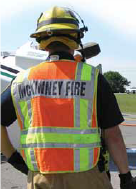Protect Your Members with High Visibility Traffic Vests
As of November 2008, if your fire department, rescue squad, fire police unit or related group is operating on the highway without approved high-visibility garments you have two problems: your members are at increased risk of injury and your organization risks penalties and litigation. That’s because, after two years of official rule-making procedures and an intense education campaign by a number of public safety organizations, 2008 Rule 23 C.F.R. Part 634 - Worker Visibility took effect.

The rule encompasses all workers on the highways, not just emergency responders. It requires that everyone wear American National Standard Institute (ANSI)-labeled garments while working on Federal-aid highways, meaning any highway constructed or maintained with federal funds. The rule is part of legislation mandated by Congress to improve worker safety on the roadways. No federal-aid highways in your district? You aren’t exempt, because the rule is slated to become part of the Federal Highway Administration’s Manual for Uniform Traffic Control Devices in 2009 and will expand to include all highways.
Complying with the rule is not particularly difficult. ANSI 107-2004 Class II vests and ANSI 207-2006 public safety vests are readily available at most uniform and safety supply outlets as well as online. Prices range from about $18 to $50 per item, and most vendors offer a substantial price break for larger orders. Roadway safety experts recommend that vests include a 4- or 5-point break-away feature that allows the vest to come apart if caught on a moving vehicle; this is to prevent the wearer from being dragged down the road.
Emergency service organizations should prepare related SOPs/SOGs and incorporate them into their manuals. Detailed information and a generic SOP may be found at www.respondersafety.com.
The site also includes explanations as to when members should not wear a vest, such as during fire-suppression activities. There are many more free resources and training materials on the site as well.

Members should be trained to understand the new SOP and know how and when to wear high-visibility garments. Company officers are responsible for ensuring that members comply, as they are with all regulations involving emergency operations. An officer has a primary responsibility for doing as much as humanly possible to protect members from injury.
A responder’s first line of defense is being seen by an approaching vehicle. The sooner an emergency responder is visible to a motorist the more time there is to slow down and move over. This fact has not been lost on con-struction workers or even on convict road gangs, who have been wearing high-visibility garments on the highway for many years.
Emergency service organizations who make little or no effort to comply with the rule and who don’t enforce the proper wearing of vests are exposed to problems in several areas. They may be in dan-ger in OSHA states of being fined for providing a less-than-safe workplace. There may also be state regulatory measures that exact penalties for non-compliance with worker safety rules.
Organizations may also be subject to civil litigation by members or their families should there be an injury or death of a responder who was not wearing a compliant garment at the time of the injury.
To avoid a tragedy, or, at the very least, an unpleasant and embarrassing citation, remember this simple vest policy: “When your feet are on the street your vest is on your chest”.

Steve Austin is the project manager of the CVVFA Emergency Responder Safety Institute. The Institute counts VFIS as valued partner in promoting safety at roadway incident scenes. The Institute owns and operates www.respondersafety.com.
Original article - Page 6 Vfis newsletter https://www.vfis.com/Portals/vfis/documents/VFIS-news/VFIS-Spring-2009-News.pdf